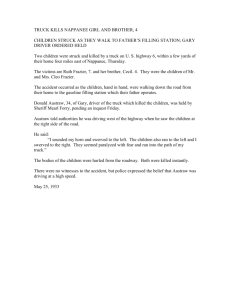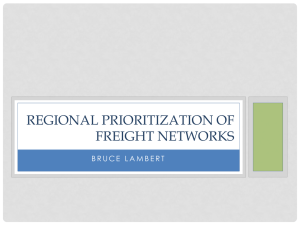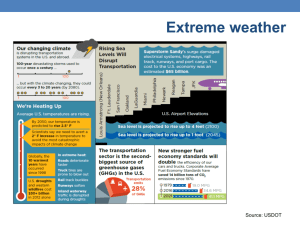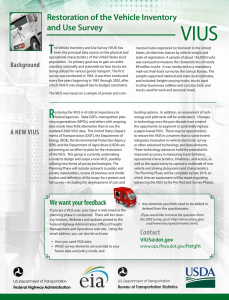Truck Size And Weight Policy-Current Activity Of The FHW A George
advertisement
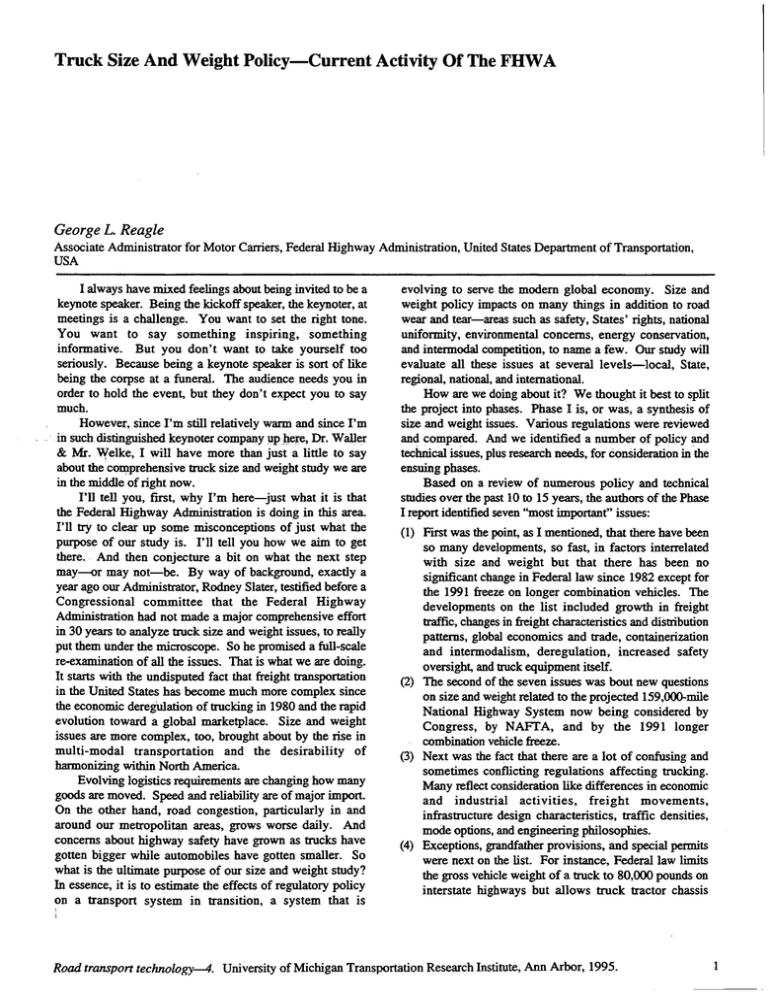
Truck Size And Weight Policy-Current Activity Of The FHWA George L. Reagle Associate Administrator for Motor Carriers, Federal Highway Administration, United States Department of Transportation, USA I always have mixed feelings about being invited to be a keynote speaker. Being the kickoff speaker, the keynoter, at meetings is a challenge. You want to set the right tone. You want to say something inspiring, something informative. But you don't want to take yourself too seriously. Because being a keynote speaker is sort of like being the corpse at a funeral. The audience needs you in order to hold the event, but they don't expect you to say much. However, since I'm still relatively warm and since I'm in such distinguished keynoter company ~p .lte~, Dr. WaIler & Mr. Welke, I will have more than just a little to say about the comprehensive truck size and weight study we are in the middle of right now. I'll tell you, first, why I'm here-just what it is that the Federal Highway Administration is doing in this area. I'll try to clear up some misconceptions of just what the purpose of our study is. I'll tell you how we aim to get there. And then conjecture a bit on what the next step may-or may not-be. By way of background, exactly a year ago our Administrator, Rodney Slater, testified before a Congressional committee that the Federal Highway Administration had not made a major comprehensive effort in 30 years to analyze truck size and weight issues, to really put them under the microscope. So he promised a full-scale re-examination of all the issues. That is what we are doing. It starts with the undisputed fact that freight transportation in the United States has become much more complex since the economic deregUlation of trucking in 1980 and the rapid evolution toward a global marketplace. Size and weight issues are more complex, too, brought about by the rise in multi-modal transportation and the desirability of harmonizing within North America. Evolving logistics requirements are changing how many goods are moved. Speed and reliability are of major import. On the other hand, road congestion, particularly in and around our metropolitan areas, grows worse daily. And concerns about highway safety have grown as trucks have gotten bigger while automobiles have goUen smaller. So what is the ultimate purpose of our size and weight study? In essence, it is to estimate the effects of regulatory policy on a transport system in transition, a system that is evolving to serve the modem global economy. Size and weight policy impacts on many things in addition to road wear and tear-areas such as safety, States' rights, national uniformity, environmental concerns, energy conservation, and intermodal competition, to name a few. Our study will evaluate all these issues at several levels-local, State, regional, national, and international. How are we doing about it? We thought it best to split the project into phases. Phase I is, or waS, a synthesis of size and weight issues. Various regulations were reviewed and compared. And we identified a number of policy and technical issues, plus research needs, for conSideration in the ensuing phases. Based on a review of numerous policy and technical studies over the past 10 to 15 years, the authors of the Phase I report identified seven "most important" issues: (1) First was the point, as I mentioned, that there have been so many developments, so fast, in factors interrelated with size and weight but that there has been no significant change in Federal law since 1982 except for the 1991 freeze on longer combination vehicles. The developments on the list included growth in freight traffic, changes in freight characteristics and distribution patterns, global economics and trade, containerization and intermodalism, deregulation, increased safety oversight, and truck equipment itself. (2) The second of the seven issues was bout new questions on size and weight related to the projected 159,OOO-mile National Highway System now being considered by Congress, by NAFrA, and by the 1991 longer combination vehicle freeze. (3) Next was the fact that there are a lot of confusing and sometimes conflicting regulations affecting trucking. Many reflect consideration like differences in economic and industrial activities, freight movements, infrastructure design characteristics, traffic densities, mode options, and engineering philosophies. (4) Exceptions, grandfather provisions, and special permits were next on the list. For instance, Federal law limits the gross vehicle weight of a truck to 80,000 pounds on interstate highways but allows truck tractor chassis Road transpon technology-4. University of Michigan Transportation Research Institute, Ann Arbor, 1995. ROAD lRANSPORT 1ECHNOLOGY-4 combinations to haul a container that has been or will be moving in international commerce at more than that weight-by simply obtaining a permit. (5) Fifth, the authors suggested consideration should be given to the enforceability of policy options. Enforcement of the existing relatively simple regulations has proven difficult for many jurisdictions. (6) They also called for further study of the intermodal implications of size and weight policy options, based on developments in domestic containerization that will impose new demands on size and weight limits. (l) Last, it was pointed out that the results of the overall study should provide a broad knowledge base that can be used for the on-going trilateral consultations on vehicle weights and dimensions that are required by NAFfA. Those were the results of Phase I. Originally, we planned to conduct a separate Phase n, a preliminary Options Analysis of the study to be completed during the summer of 1995. Phase n was primarily focused on the implications of extending Federal truck size and weight controls to the National Highway System (NHS) as proposed in H.R. 4496 of the 103rd Congress. However, it looks like the NHS legislation will not address the issue of truck size and weight so we are able to modify the original work plan to combine the Phase IT work that had been started into a significantly broadened Phase ID. That means our current study efforts have largely been shifted toward planning for the expanded analysis. Thus, Phase ill will be the extended impact analysis, using the data and new tools becoming available in 1995 and 1996 to prepare ~::1-depth analyses of the Phase n policy options. It will incorporate results from a parallel cost allocation study to determine whether the various highway users are paying their fair share into the Highway Trust Fund. We will be weighing data on freight flows and truck use to develop specific policy options addressing the full range of estimated costs and benefits. This will be cOncluded by the end of next year, 1996. Let me tell you this is no easy task. We have already identified a long list of policy issues that must be addressed as we seek to produce safer trucks and more efficient truck service and improve the environment. As a sample, these include pavement issues like: • Load limits and tire regulations; • The bridge formula and tridem axles; • Roadway geometry, which involves total length limits and offtracking regulations; • Traffic operations-how trucks and automobiles can most safely share the road; and, of course, • Truck crashes. To address these issues-and they are just a sample-we have an ambitious six-pronged ''technical approach." The first of those six approaches we call the Freight Market Analysis. This will be an "identifying" phase. Identifying national and international changes in freight distribution. Identifying market segments. Identifying freight market trends. And identifying preliminary options. Then, after taking public comment on our lists, we will 2 convene shipper and carrierlbroker focus groups to get their expert reactions. Activity two will consist of a multi-modal transportation industry analysis and case studies. It will be subdivided into have parts. We will begin by identifying modal responses to regulatory and other changes-past, present, anC: future. Then will be freight corridor and commodity case studies. Then an analysis of freight diversion for all modes. And last will be analysis of local trucking and preparation of a summary report on freight diversion. The third of the "big six" elements will be examination of highway infrastructure and operations. This will involve research and evaluation of the impacts on bridges, pavements, and traffic operations. Plus, there will be an evaluation of roadway geometry limitations and an assessment of means to resolve cost recovery issues. Safety is next. It will start with an evaluation of vehicle stability and control performed of various truck configurations. Past accident data, particularly where fatalities were involved, will be carefully analyzed. And much use will be made of current analysis of driver fatigue, which was identified at our recent first-ever Truck and Bus Safety Summit as being the top issue needing attention. Activity five will consist of performance-based and other approaches to size and weight regulations. We will examine the North American and European experience. We will examine the feasibility of a performance-based approach in the United States. We will examine advances and other changes in truck technology. And we will identify and assess enforcement issues and potential solutions. The last of the six activities calls for an analysis of full benefits and costs of policy options. Focus groups againthis time automobile drivers and trucking industry employees-to get reaction to preliminary policy proposals. And, of course, the wrap-up will be the preparation of a final report. This is a good point to put to rest some misconceptions that seem to have arisen around this entire effort. We are not in the business, in this study, of making policy, of recommending longer, wider, or heavier trucks. Only Congress can make policy. All we can do is give Congress what in effect is spread sheet of possible options. Then Congress can adopt them in whole or in part. Or rework them into something hardly recognizable. Or, of course, totally reject or ignore anything we might come up with. I stress this to put to rest innuendoes that we in Federal Highway seem to be biased in favor of larger trucks. We have no preconceptions. We want to have the benefit of the full range of issues, arguments, statistics, and so forth. We want the reactions of focus groups, of industry, of safety advocates. We want-we sincerely, invite--comments from anyone, and will officially be requesting them in Federal Register notices. I have no idea. naturally, what the result will be. I can state with certainty, though, that all of us-the Department of Transportation, Congress, the trucking industry-are committed to moving our transportation into the 21st century in an even better position from safety perspective as well as from global competitive and technology.

